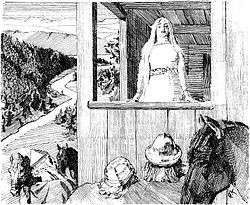Gyda Eiriksdatter

Gyda Eiriksdottir of Hordaland (Gyða Eiríksdóttir) was a semi-legendary Norwegian queen consort during the Viking Era. She appears in the Saga of Harald Fairhair (Harald Hårfagres saga) in Snorri Sturluson's Heimskringla.[1]
Biography
The legend of Gyda describes the unification of Norway as somewhat of a love story. Gyda was born c. 852 in Hordaland. She was the daughter of Eirik, king of Hordaland, (Eirik af Hordaland), one of the petty kings of pre-united Norway. Gyda was proposed to by Harold Fairhair who was then the king of the petty kingdom of Vestfold.[2]
She answered that she refused to marry Harald "before he was king over all of Norway". Harald was therefore induced to take a vow not to cut nor comb his hair until he was sole king of Norway. Ten years later, in 872, Harald was now king of united Norway. He was justified in trimming his hair; whereupon he exchanged the epithet "shockhead" or "tanglehair" for the one by which he is usually known. He sent for Gyda reminding her of the promise she made and they were married.[3]
Most scholars today regard this story as a truthful representation of the romance stories that were popular at the time Heimskringla was written in the 13th Century.
Children
- Ålov Årbot Haraldsdotter[4]
- Rørek Haraldsson
- Sigtrygg Haraldsson
- Frode Haraldsson
- Torgils Haraldsson
Primary Sources
The primary records are from the Heimskringla by Snorri Sturlasson.
References
- ↑ Snorre Sturlasøn. "Harald Haarfagres saga". Heimskringla.no. Retrieved May 25, 2016.
- ↑ "Gyda Eiriksdotter (Gyða Eiríksdóttir)". Det Norske Samlaget. Retrieved May 25, 2016.
- ↑ Mary MacGregor. "Stories of the Vikings - Harald Fairhair". The Baldwin Project. Retrieved May 15, 2016.
- ↑ "Ålov Årbot (Haraldsdotter) (Ólöf árbót)". Det Norske Samlaget. Retrieved May 25, 2016.
| Gyda Eiriksdatter | ||
| Preceded by None, new title |
Queen Consort of Norway 872–930 |
Succeeded by Gunnhild, Mother of Kings |